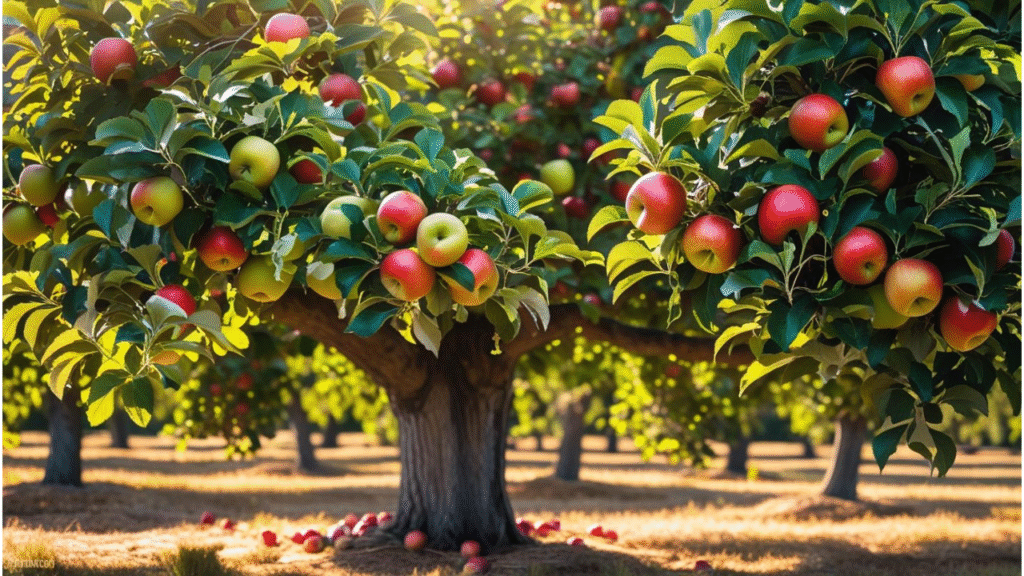
Essential Apple Tree Spray: How to Protect Your Trees from Pests and Diseases Effectively
Are pests and diseases wreaking havoc on your apple trees? 🍏 If you’ve noticed leaves turning yellow, spots appearing on your fruit, or an army of aphids taking over your branches, it’s time to act. Apple tree spray is one of the most effective ways to safeguard your trees, but knowing when and how to apply it can be a bit overwhelming for beginners.
In this guide, we’ll break down everything you need to know about apple tree spray—why it’s essential, the different types available, and how to apply it for maximum protection. Whether you’re dealing with pesky insects or harmful fungal diseases, we’ve got you covered. By the end of this article, you’ll have the confidence to protect your trees and ensure they thrive season after season. 🌳 Keep reading to learn how simple steps can lead to healthier, more productive apple trees!
Table of Contents
Toggle🍏 Understanding the Need for Apple Tree Spray 🍏
Apple trees are beautiful 🌳, but they’re not immune to pests 🐛 and diseases 🦠 that can severely impact their health and fruit 🍏 production. Whether you’re a seasoned gardener 🌱 or just starting out, understanding the importance of apple tree spray 🌿 is essential to keeping your trees healthy and productive.
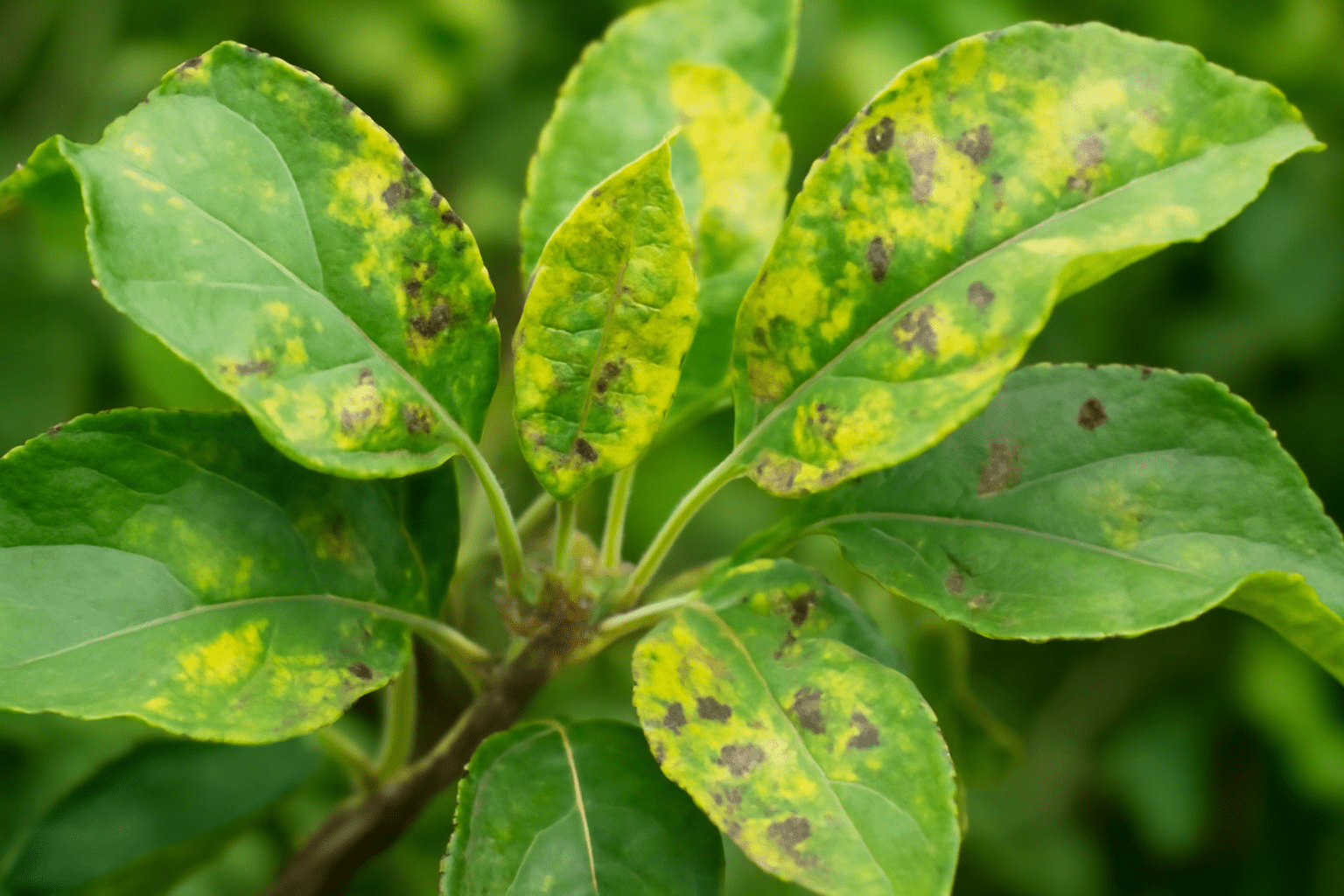
🐞 Why Apple Trees Need Protection 🌿
Apple trees are particularly vulnerable to a range of pests 🐜 and diseases 🦠. Common culprits include:
- Aphids 🐜: These tiny insects suck the sap 💧 from leaves 🍃 and branches 🌿, weakening the tree 🌳 and spreading diseases 🦠.
- Apple Scab 🍏: A fungal disease 🦠 that causes dark, scabby spots on leaves 🍃 and fruit 🍏, making them unsightly and unhealthy.
- Powdery Mildew 🌬: This fungal infection 🦠 covers leaves 🍃 with a white, powdery substance, reducing photosynthesis ☀️ and stunting growth 🌱.
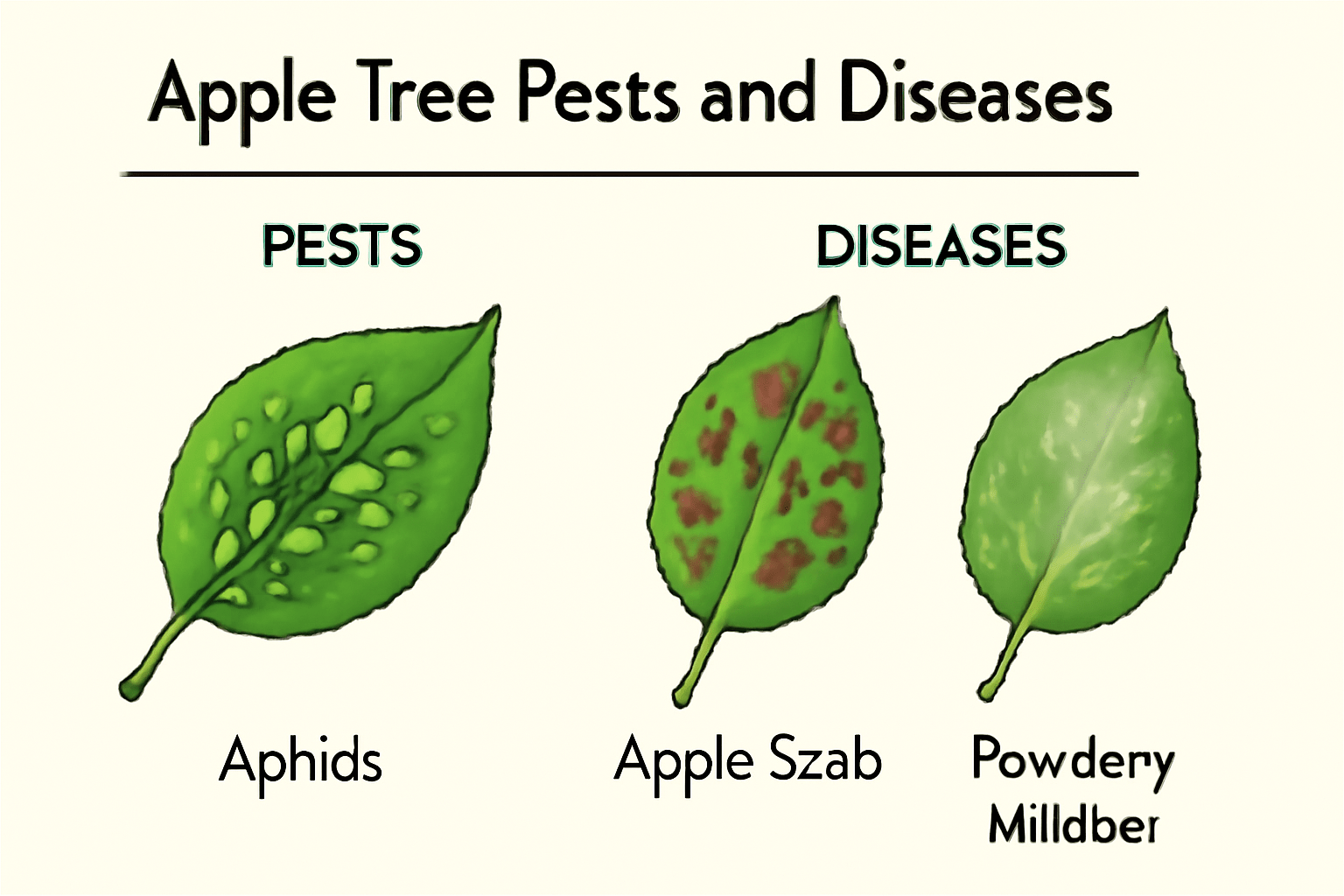
Without proper protection 🛡️, your apple tree 🌳 could suffer from reduced fruit 🍏 yield, slower growth 🌱, or even premature death ☠️. That’s where apple tree spray 🌿 comes in!
🛡️ The Benefits of Apple Tree Spray 🍎
Using apple tree spray 🌿 helps:
- Prevent Pest Infestations 🐞: Sprays create a barrier 🛡️ that prevents pests 🐜 from attacking your tree 🌳, ensuring it stays healthy 💪.
- Fight Diseases 🦠: Fungicides 💊 in apple tree sprays 🌿 prevent the spread of harmful diseases like scab 🍏 and mildew 🍃.
- Improve Fruit Quality 🍏: Healthy trees 🌳 produce better fruit 🍎—clean, shiny apples 🍏 that are both delicious 😋 and safe to eat.
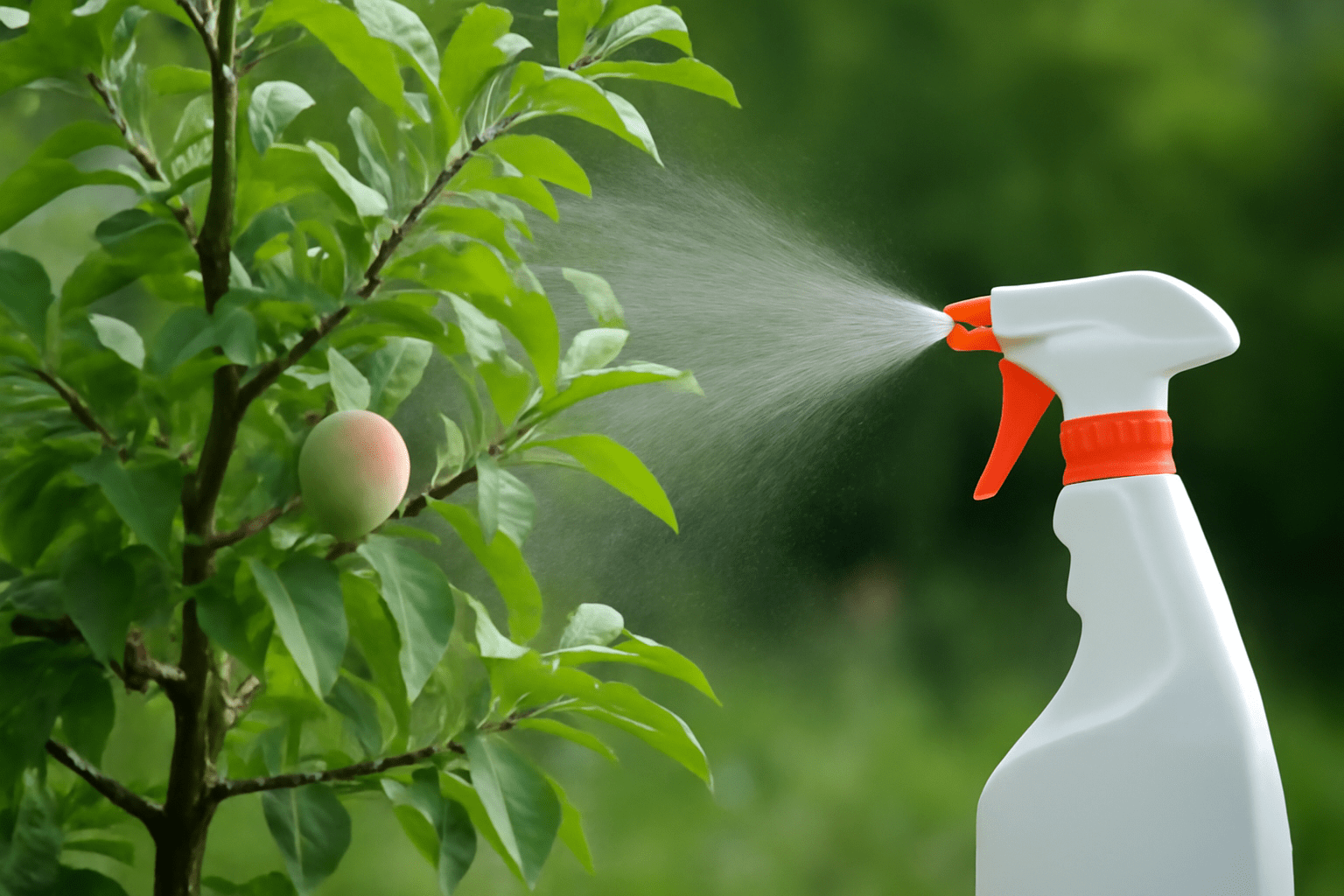
By applying the right spray 🌿 at the right time 🕒, you’ll be able to keep your trees 🌳 strong 💪, resilient 💪, and ready to produce an abundant harvest 🍏 year after year. 🌟
In the next section, we’ll dive deeper 🔍 into the different types of sprays available 🌿 and how they work to protect your trees 🌳. Stay tuned! ✨
🍏 Types of Apple Tree Sprays and Their Functions 🍏
When it comes to protecting your apple trees 🌳, choosing the right spray 🌿 is key. There are two main categories of apple tree sprays 🌱: organic and chemical. Let’s break down both types to help you make an informed decision 💡 that best suits your needs. 🌱
🌿 Organic vs. Chemical Sprays 🌿
Organic Sprays 🌱
These sprays 🌿 are derived from natural ingredients 🌍 and are often preferred by gardeners looking to minimize their environmental impact 🌎.
- Neem Oil 🌿: A powerful organic insecticide 🦠 and fungicide 🍄 that works by disrupting the life cycle of pests 🐜.
- Insecticidal Soap 🧼: A gentle yet effective solution for controlling aphids 🐞, mealybugs 🐜, and spider mites 🕷️.
- Horticultural Oils 🌾: These oils suffocate pests like scale insects 🐜 and aphids 🐞 without leaving harmful residues.
Chemical Sprays 💥
These sprays 🌿 are made with synthetic compounds designed to target specific pests 🐛 or diseases 🦠. They tend to be more powerful ⚡ but come with certain risks ⚠️.
- Synthetic Pesticides 🧪: Chemical insecticides 🦠 that effectively kill a wide range of pests 🐛 but may affect beneficial insects 🐝 and pollinators 🐦.
- Fungicides 🍄: Used to combat fungal diseases like apple scab 🍏, mildew 🍃, and rust 🍂. They are often more potent ⚡ but can harm the environment 🌍 if overused.
- Herbicides 🌿: These control weeds 🌱 around the apple tree 🌳, but they may also affect surrounding plants 🌸 and the soil 🌍.
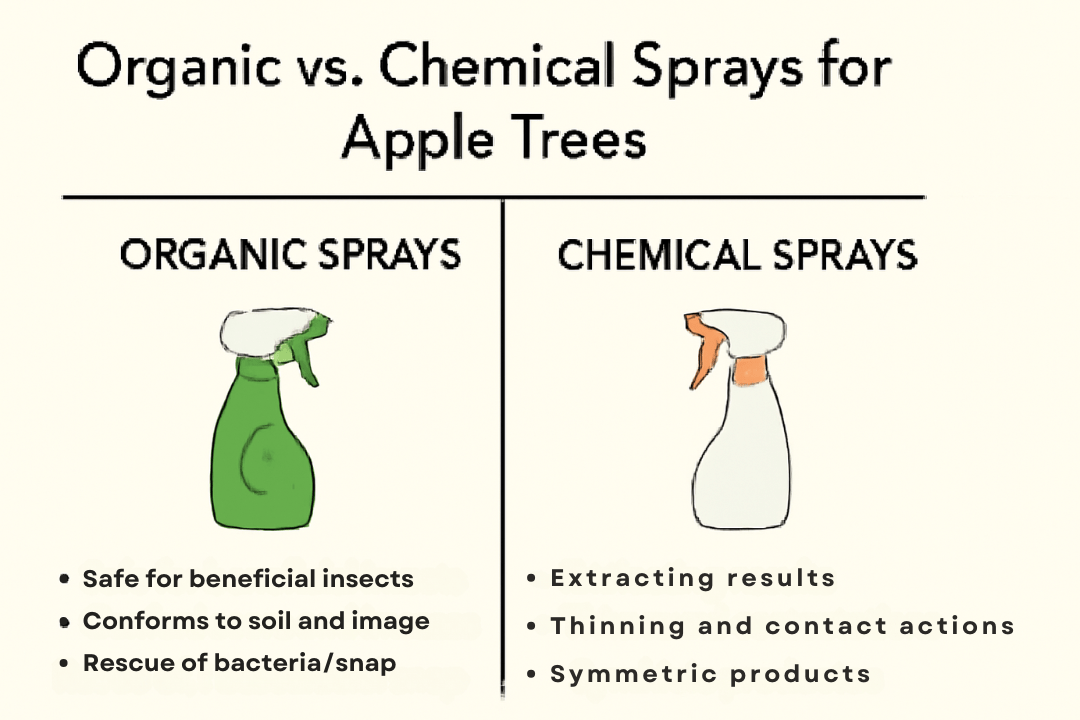
🌟 Pros and Cons: Comparing Effectiveness, Safety, and Environmental Impact 🌍
Organic Sprays 🌱
Pros:
- Safe for beneficial insects like bees 🐝 and ladybugs 🐞.
- Less harmful to the environment 🌎.
- Often non-toxic to humans 👨👩👧👦 and pets 🐶.
Cons:
- May require more frequent applications 🔁.
- Can be less effective on heavy infestations 😷.
Chemical Sprays 💥
Pros:
- Highly effective at killing pests 🦠 and preventing diseases 🦠.
- Fewer applications may be needed ⏳.
Cons:
- Can harm beneficial insects 🐝 and pollinators 🐞.
- Potentially harmful to the environment 🌎, especially if overused 🌍.
- May leave residues on fruit 🍏.
🐛 Common Types of Apple Tree Sprays 🍏
To protect your apple tree 🌳, it’s important to understand the different types of sprays 🌿 you might need, depending on what you’re dealing with:
Insecticides 🐜
Protect your apple tree 🌳 from pests 🐛 like aphids 🐞, caterpillars 🐛, and moths 🦋, which can drain the tree’s energy ⚡ and damage fruit 🍏. Common insecticides include both organic options like neem oil 🌿 and chemical options like pyrethrin 💥.
Fungicides 🍄
Prevent the spread of fungal diseases 🍂 like apple scab 🍏, rust 🍂, and powdery mildew 🌬. Fungicides help ensure your tree 🌳 remains disease-free 🦠, especially during wet seasons when these problems thrive 🌧️. Both organic and chemical fungicides are available 🌿.
Herbicides 🌿
Weeds 🌱 can compete with your apple tree 🌳 for nutrients 🍽️, so using herbicides 🌿 around the base of the tree 🌳 is important to keep unwanted plants 🌸 in check. Use with caution ⚠️, as some herbicides may affect the soil 🌍 or nearby plants 🌺.
Horticultural Oils 🌾
These oils are a more environmentally friendly 🌍 option, used primarily to control pests 🐜 like scale insects 🐛 and mites 🐜. They work by suffocating the pests 🐜, without affecting the tree 🌳 or surrounding environment 🌎.
By understanding the types of apple tree sprays 🌿 and their functions ⚙️, you can make an informed choice 🧐 to protect your trees 🌳 while considering safety 🛡️ and environmental impact 🌍. Stay tuned for the next section, where we’ll discuss when to apply apple tree spray 🌿 for maximum effectiveness! 🌳✨
🍏 When to Apply Apple Tree Spray 🍏
Knowing when to apply apple tree spray 🌿 is just as important as knowing what kind to use 🧐. Timing is crucial ⏰ to maximize effectiveness 💥, prevent pests 🐜, and ensure healthy growth 🌱 throughout the season. Let’s dive into the best times 🕒 to spray your apple trees 🌳 and how frequently it should be done.
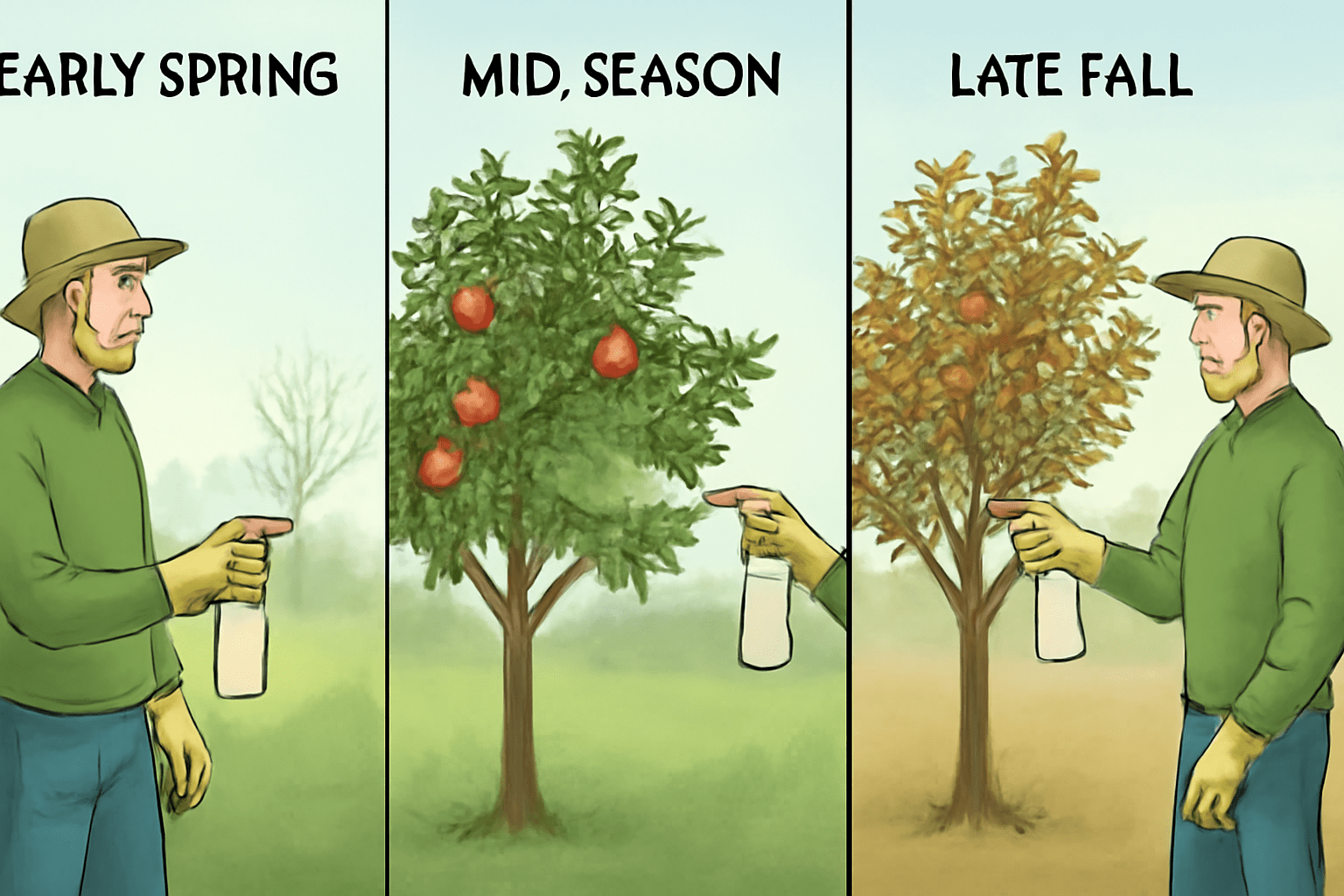
🌸 Timing of Application 🌸
1. Early Spring – Preventing Pests Before They Emerge 🌱
Spring 🌸 is a critical time for apple trees 🌳. As the weather warms up 🌞, pests 🐜 like aphids 🐞, caterpillars 🐛, and scale insects 🐜 start to emerge. Spraying in early spring (before buds break 🌱) is essential to prevent these pests from taking hold. This is when you should apply dormant oil 🛢️ to target overwintering pests 🐜 and their eggs 🥚, which helps prevent an infestation later on.
Tip: Apply dormant oil 🛢️ when the temperature is above 40°F (4°C) and before new growth appears 🌿.
2. During the Growing Season – Targeting Pests and Diseases Actively Affecting the Tree 🌳
Once the growing season 🌿 is in full swing ⚡, pests 🐛 like aphids 🐞 and diseases 🦠 like apple scab 🍏 become more active. This is when you should apply insecticides 💥 and fungicides 🍄 to protect your tree 🌳. Regular applications every 7–14 days 🔄 can help manage pests 🐜 and prevent diseases 🦠 from spreading, especially during wet weather 🌧️.
Tip: If you notice any signs 👀 of pests 🐜 or disease 🦠, act quickly ⚡ to stop the problem before it escalates 🚨.
3. Late Fall – Winterizing Your Tree with Dormant Oil 🍂
Late fall 🍁 is the perfect time ⏰ to prepare your tree 🌳 for the winter months ❄️. Applying dormant oil 🛢️ in late fall helps control pests 🐜 that might be hiding in the tree 🌳 during winter ❄️ and prevents them from emerging in the spring 🌷. This also helps protect the tree 🌳 from fungal spores 🍄 over the winter months.
Tip: Apply dormant oil 🛢️ once the tree has gone dormant 🌙 (typically after the leaves 🍂 have fallen) and before the first hard frost ❄️.
🗓️ Frequency of Application 🗓️
How Often Should You Spray? ⏳
The frequency of spraying 🧴 depends on the type of spray 🌿 you use, the severity of the pest 🐜 issue, and weather conditions 🌦️. As a general rule:
- Insecticides/Fungicides 🍄: Spray every 7–14 days during the growing season 🌿, or as directed on the product label 🏷️.
- Dormant Oil 🛢️: Apply once in late fall 🍁 or early spring 🌷 before new buds break 🌱.
Environmental Factors that Influence Frequency 🌍
Certain weather conditions 🌦️ can affect how often you need to apply sprays 🧴:
- Wet Weather 🌧️: Rain 🌧️ encourages fungal growth 🍄, meaning you may need to spray more often to prevent diseases like apple scab 🍏.
- Dry Weather 🌞: Pests 🐜 may become more active in dry conditions ☀️, so regular applications of insecticides 💥 may be needed to combat them.
Tip: Always check the product instructions 📜 for specific recommendations, as some sprays 🌿 may need reapplication after rain 🌧️ or after a certain number of days.
By applying apple tree spray 🌿 at the right times 🕒 and with the correct frequency 🔄, you’ll give your trees 🌳 the best chance at staying healthy 💪 and productive 🍏. In the next section, we’ll go over how to apply apple tree spray 🌿 effectively for maximum protection! 🌟
🍏 How to Apply Apple Tree Spray Effectively 🍏
Applying apple tree spray 🌿 properly is essential for ensuring maximum effectiveness 💥 while keeping your tree 🌳, the environment 🌍, and beneficial insects 🐝 safe. Let’s walk through the key steps 📝 for preparing and applying your spray correctly.
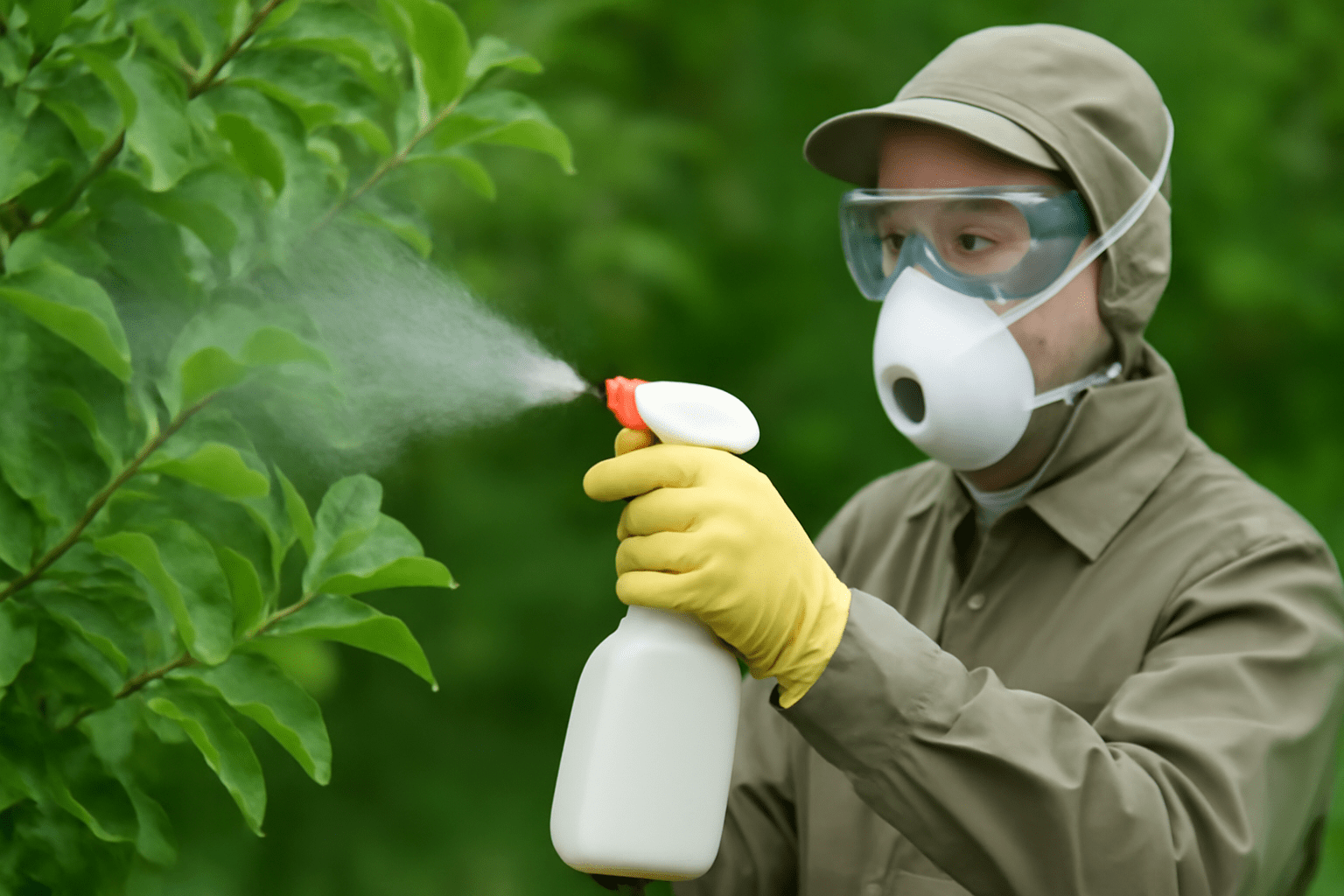
🧑🍳 Preparation Steps 🧑🍳
1. Read the Label – Understanding the Product and Its Safety Measures 📜
Before using any spray 🧴, always read the label thoroughly 🧐. The label will provide important information 📋 such as:
- Active ingredients 🧪: Know what’s in the product and what it targets 🎯.
- Safety measures 🦺: Check for precautions to protect yourself 👨👩👧👦, others 🧑🤝🧑, and the environment 🌍.
- Application instructions 📝: Follow the recommended dosage 💧, dilution ratio ⚖️, and timing 🕒 for best results.
2. Mix the Solution – Correct Dilution Ratios for Effective Treatment ⚖️
Ensure that you are mixing the solution 🧴 according to the instructions on the product label 📜. Too much spray can damage your tree 🌳, while too little may not be effective 💥.
Tip: Use a clean container 🍶 to mix the solution. Never store mixed sprays 🧴 for long periods ⏳ as they lose their effectiveness.
3. Equip Yourself with Protective Gear 🧤
Safety is a priority! While applying apple tree spray 🌿, wear the proper protective gear 🦺 to prevent exposure to chemicals 🧪:
- Gloves 🧤: Protect your hands ✋ from harmful chemicals.
- Goggles 👓: Shield your eyes 👀 from splashes 💦.
- Mask 😷: Wear a mask 🪶 to avoid inhaling any fumes 💨, especially with chemical sprays 🧴.
🌅 Application Tips 🌅
1. Spray in the Early Morning or Late Evening to Avoid Harming Beneficial Insects 🐝
The best time ⏰ to apply spray 🌿 is early in the morning 🌅 or late in the evening 🌙 when beneficial insects 🐝 like bees 🐝 and ladybugs 🐞 are less active. This helps avoid harming them while still protecting your trees 🌳.
Tip: Avoid spraying during the heat of the day 🌞, as the spray 🌿 may evaporate too quickly or damage the tree 🌳.
2. Apply Evenly – Covering Both Sides of Leaves and Branches 🍃
For the spray 🌿 to be effective 💥, it’s important to cover both the tops and undersides of the leaves 🍃 and branches 🌿. Pests 🐜 often hide on the underside of leaves 🍃, so thorough coverage is essential for proper protection 🛡️.
Tip: Use a sprayer 💦 with adjustable nozzles to help direct the spray 🌿 where it’s needed most.
3. Ensure Proper Coverage – Focus on the Undersides of Leaves 🍃
Many pests 🐜, like aphids 🐞 and mites 🐜, hide on the undersides of leaves 🍃, so it’s crucial to apply spray 🌿 in these areas. Pay close attention 👀 to these spots during your application to ensure pests 🐜 are targeted where they are most active 💥.
Tip: Don’t rush ⏳ the application. Take your time 🕰️ to ensure even coverage 🌿 on all surfaces of the tree 🌳.
By following these preparation steps 📝 and application tips 🌿, you’ll ensure that your apple tree spray 🌿 is applied effectively, providing the best protection 🛡️ for your tree 🌳. In the next section, we’ll cover common mistakes ❌ to avoid when using apple tree spray 🌿, so you can achieve the best results and avoid harming your tree 🌳 or the environment 🌍.
🍏 Common Mistakes to Avoid When Using Apple Tree Spray 🍏
While apple tree spray 🌿 is a powerful tool 🛠️ for protecting your trees 🌳, it’s easy to make mistakes that can reduce its effectiveness 💥 or harm the environment 🌍. Let’s take a look 👀 at the most common pitfalls 🕳️ gardeners make and how to avoid them.
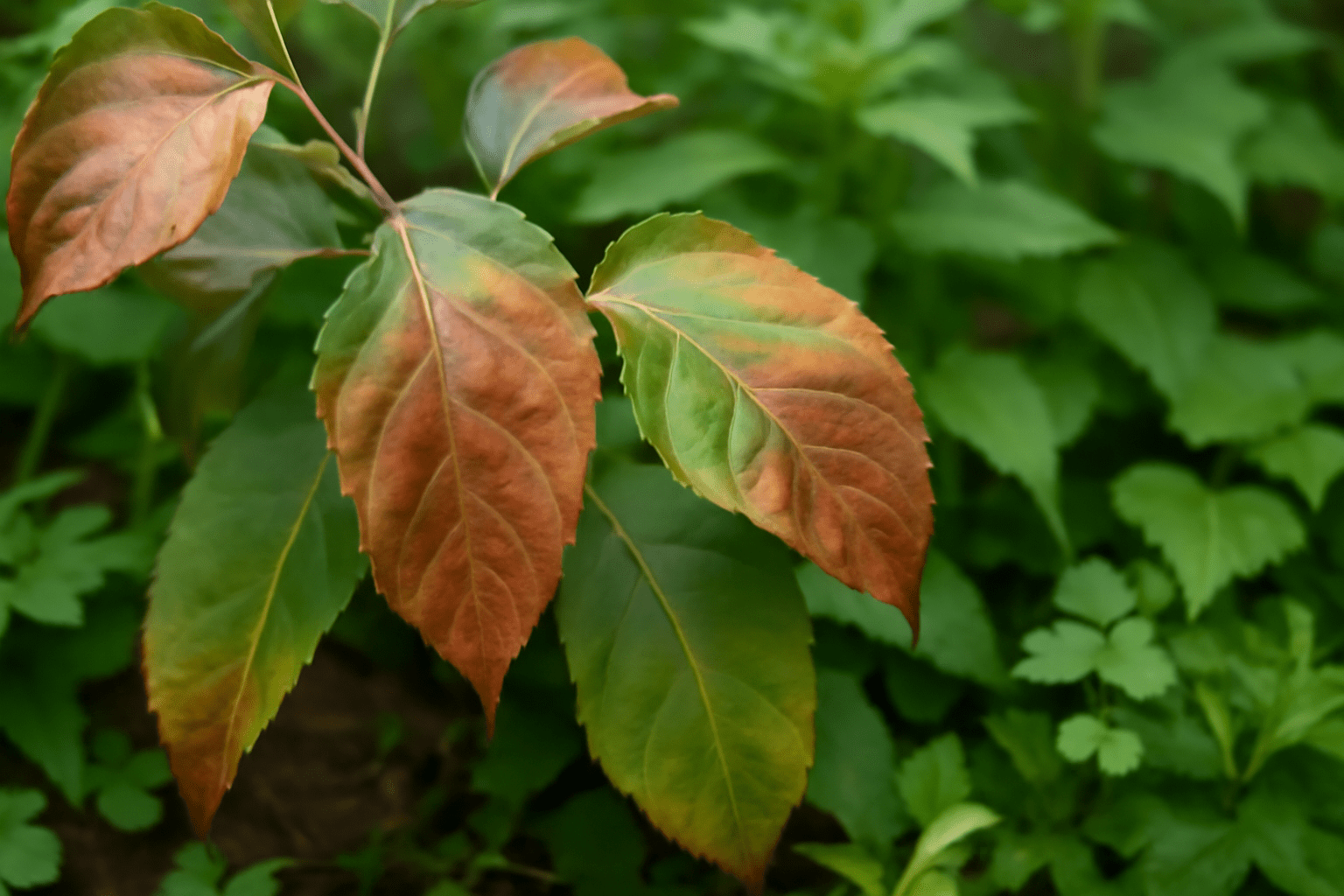
❌ Over-Application ❌
Dangers of Applying Too Much Spray 💧
Over-spraying 🌿 is a common mistake ❌ that can have serious consequences ⚠️. Applying too much spray can:
- Harm the Tree 🌳: Excessive chemicals 🧪 can burn 🔥 leaves 🍃 or damage the tree’s sensitive tissue 💔, causing long-term damage 🕰️.
- Harm the Environment 🌍: Over-spray 🌿 can drip onto nearby plants 🌸, polluting the soil 🌱 and water 💧, and harming beneficial insects 🐝.
- Reduce Effectiveness ⚡: Over-application doesn’t necessarily mean better protection 🛡️. It can overwhelm the tree 🌳 and reduce the overall effectiveness 🛑 of the treatment.
How to Avoid Over-Application
To prevent over-spraying 🌿, always follow the manufacturer’s guidelines 📜 on the product label 🏷️. Pay close attention 👀 to the recommended amount to use and dilution instructions ⚖️.
Tip: Use a measuring cup 🍶 when mixing the spray 🧴 to ensure accuracy 📏. You can also use a sprayer 💦 with a built-in guide 📏 to help regulate the amount applied.
🌧️ Ignoring the Weather Forecast 🌬️
Why Spraying Just Before Rain or High Winds Can Make Your Efforts Less Effective 🌧️
Weather 🌦️ plays a crucial role in the success 🏆 of apple tree spray 🌿:
- Rain 🌧️: Spraying right before it rains 🌧️ can wash away the spray 🌿 before it has a chance to work 💨, leaving your tree 🌳 unprotected.
- High Winds 🌬️: Windy conditions 🌬️ can blow the spray 🌿 off-target 🎯, meaning it won’t reach the tree 🌳 or pests 🐜.
Best Practices for Checking the Weather
Before spraying 🌿, check the weather forecast 🌦️ for rain 🌧️, strong winds 💨, or high temperatures 🌡️. Ideally, you want to spray when it’s dry 🌞 and calm 🕊️, allowing the spray 🌿 to dry and stick to the tree 🌳 for maximum effect 💥.
Tip: Aim to spray 🌿 in the morning 🌅 or evening 🌙 when there’s minimal wind 🌬️ and no rain 🌧️ expected for at least 24 hours ⏳.
🔄 Inconsistent Application 🔄
The Importance of Regular, Consistent Spraying 🧴
Apple tree spray 🌿 is most effective 💥 when applied regularly 📅. Inconsistent application ❌ can lead to:
- Pest Resurgence 🐜: Pests 🐜 can return if you don’t spray consistently, leading to a bigger problem 🐛.
- Increased Risk of Disease 🦠: If fungicides 🍄 are applied sporadically, diseases like apple scab 🍏 can take hold.
How to Maintain Consistency
Set a schedule 🗓️ for spraying 🌿 based on the product instructions 📜, environmental conditions 🌦️, and the time of year 📅. Remember that it’s easier and more effective 💪 to prevent a problem 🛑 than to deal with a full-blown infestation 🐜 or disease outbreak 🦠.
Tip: Mark a calendar 📅 or set reminders ⏰ to ensure you apply sprays 🌿 on time ⏳ and at the right intervals 🕒.
By avoiding these common mistakes 🛑—over-application, ignoring the weather 🌦️, and inconsistent spraying 💦—you’ll ensure that your apple trees 🌳 get the protection 🛡️ they need without harm 🚫. In the next section, we’ll go over troubleshooting common problems 🔧 with apple tree spray 🌿 to help you tackle any issues 🐜 that may arise. 🌿
🍏 Troubleshooting Common Problems with Apple Tree Spray 🍏
Even with the best intentions 💚, things can sometimes go wrong when using apple tree spray 🌿. Whether it’s tree injury 🌳, ineffective pest control 🐜, or other issues 😕, it’s important to know how to address them quickly ⏳. Let’s look at some common problems 🐜 and how to troubleshoot them to keep your apple trees 🌳 healthy and thriving 🌱.
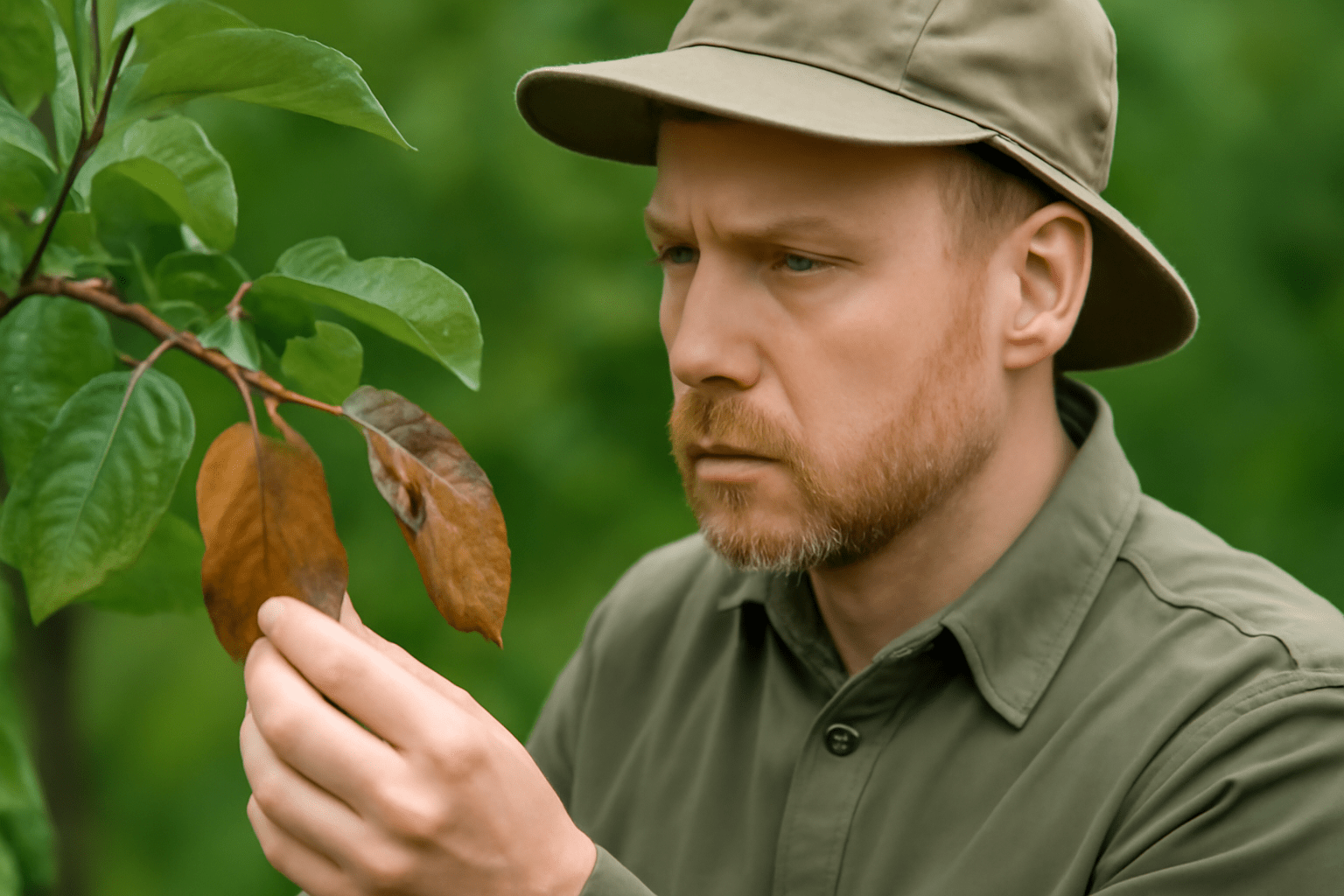
🔥 Tree Injury or Burn 🔥
Signs of Over-Spray or Incorrect Application 💧
Over-spraying 🌿 or using the wrong product 🧪 can cause visible damage 👀 to your apple tree 🌳. Here’s what to look out for:
- Browning Leaves 🍂: Leaves 🍃 may turn brown, crispy, or burn along the edges 🔥.
- Wilting or Drooping 🌿: The tree 🌳 may appear stressed 😓, with leaves 🍃 wilting or hanging limp.
- Spots or Discoloration 🌟: You may notice irregular spots 🔲 or a yellowing of the leaves 🍃, which are signs of chemical burn 🧪.
Steps to Take if This Happens
If you notice signs of injury or burn 🔥, don’t panic! 😱 Here are some steps you can take:
- Prune Affected Branches ✂️: If the damage is localized 🌿, trim away any affected branches 🌳 to help the tree 🌳 recover. This also helps prevent further stress 🥵 on the tree.
- Switch to a Gentler Product 🌿: If your current spray 🧴 is too harsh, consider switching to a gentler 🌱, more organic option like neem oil 🌿 or insecticidal soap 🧼.
- Water Well 💧: If the tree 🌳 has been over-sprayed 🌿, give it plenty of water 💦 to help dilute any excess chemicals 🧪 and prevent further damage 🔥.
Tip: Always test 🧪 new products on a small area of the tree 🌳 before applying them to the entire tree 🌳 to avoid widespread damage 🛑.
🐛 Ineffective Pest Control 🐛
Why the Spray May Not Be Working 💧
Sometimes, despite your best efforts 💪, apple tree spray 🌿 doesn’t seem to control pests 🐜 as expected. This could be due to several reasons:
- Wrong Product 🧪: Using the wrong type of spray 🧴 for the pest 🐜 you’re targeting. For example, insecticides 💥 may not work on fungal infections 🍄, and fungicides 🍄 won’t kill insects 🐜.
- Timing Issues ⏳: If you’re spraying 🌿 at the wrong time 🕒, like when pests 🐜 are in a less vulnerable stage (e.g., larvae 🐛 or eggs 🥚), the spray 🌿 might not be as effective 💥.
- Resistance 🦠: Pests 🐜 can develop resistance 💪 to certain chemicals 🧪, reducing the effectiveness of your spray 🌿 over time 🕰️.
Adjusting Application Methods or Switching Products 🔄
If your spray 🌿 isn’t working, here’s what you can do:
- Reevaluate Your Product 🧪: Make sure you’re using the correct product 🧴 for the pest 🐜 or disease 🦠 you’re trying to control. If you’re unsure, research the pest’s life cycle 🔄 to determine the best time ⏳ for treatment.
- Change Your Application Method 💦: Ensure you’re applying the spray 🌿 evenly 🔄, especially on the undersides of leaves 🍃 and branches 🌿 where pests 🐜 often hide. Consider using a different sprayer 💦 to ensure proper coverage 🌿.
- Switch Products 🔄: If resistance 🦠 is an issue, try switching 🔄 to a different type of insecticide 💥 or fungicide 🍄. Organic sprays 🌱 like neem oil 🌿 can also be effective 💥 in rotating with synthetic products 🧪.
Tip: If pests 🐜 continue to thrive despite your efforts 💪, you may want to consult a local garden center 🌱 or expert 🧑🌾 to get advice 🧠 on the best approach 🔧 for your specific problem 🐜.
By understanding and troubleshooting these common issues—tree injury 🌳 and ineffective pest control 🐜—you can take quick action 🏃♂️ to get your apple tree 🌳 back on track 🚂. In the next section, we’ll explore natural alternatives 🌿 to chemical apple tree sprays 🌿 for those who prefer a more eco-friendly ♻️ approach to pest 🐜 and disease 🦠 control. 🌿🍏
🍏 Natural Alternatives to Chemical Apple Tree Sprays 🍏
For gardeners 🌿 who prefer an eco-friendly ♻️ approach to pest 🐜 and disease 🦠 control, natural alternatives 🌱 to chemical apple tree sprays 🧴 can be just as effective 💥 and much gentler on the environment 🌍. Let’s explore some popular DIY apple tree spray recipes 🧑🍳 and the benefits of choosing natural options for your apple trees 🌳.
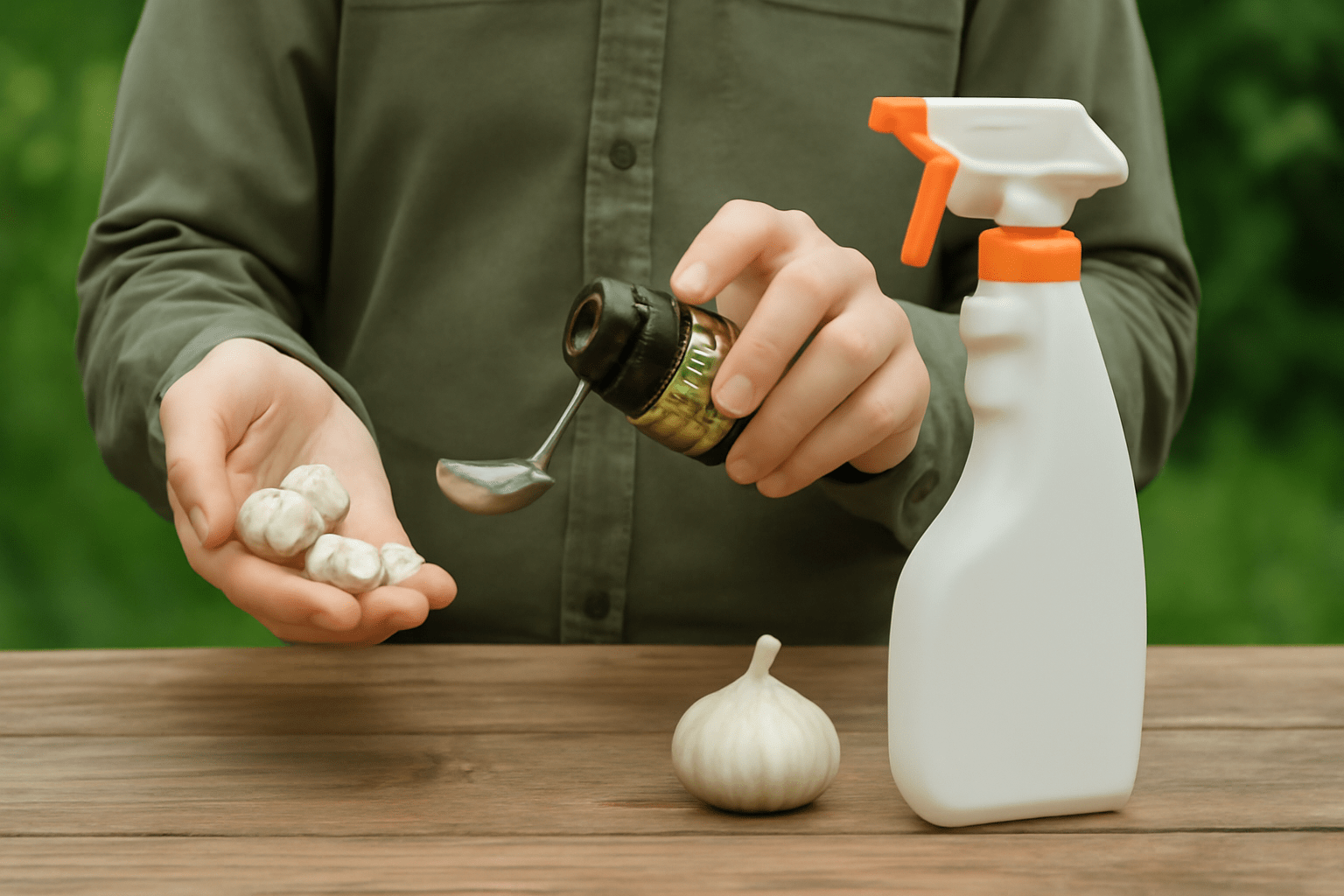
🧴 DIY Apple Tree Spray Recipes 🧴
1. Neem Oil and Soap Solution 🌿
Neem oil 🌱 is a powerful, organic pesticide 🧪 that can help control a variety of pests 🐜, including aphids 🐞, scale insects 🐜, and whiteflies 🦟. When combined with insecticidal soap 🧼, it creates a potent solution that also helps control fungal diseases 🍄 like powdery mildew 🌬️.
How to Mix:
- 2 teaspoons of neem oil 🌿
- 1 teaspoon of mild liquid soap 🧼 (like castile soap)
- 1 quart of water 💧
How to Apply:
- Shake the mixture well before use 🌀.
- Spray thoroughly on both sides of the leaves 🍃 and branches 🌿, ensuring even coverage 🌿.
- Apply in the early morning 🌅 or late evening 🌙 to avoid harming beneficial insects 🐝 like bees.
2. Garlic or Pepper Spray 🧄🌶️
Both garlic 🧄 and pepper 🌶️ contain natural compounds 🧪 that repel pests 🐜 while being safe for the tree 🌳 and the environment 🌍. These sprays 🌿 can be especially effective against aphids 🐞, spider mites 🕷️, and caterpillars 🐛.
How to Mix:
- 2 cloves of garlic 🧄 (crushed) or 1 tablespoon of ground cayenne pepper 🌶️
- 1 quart of water 💧
- 1 teaspoon of liquid soap 🧼 (to help the mixture adhere to the leaves 🍃)
How to Apply:
- Blend the garlic 🧄 or pepper 🌶️ with water 💧 and let it sit for about an hour 🕒.
- Strain the solution to remove solid particles 🧂 before transferring it to a sprayer 💦.
- Spray evenly 🌿 on the affected areas of the tree 🌳.
🌟 Benefits of Using Natural Alternatives 🌟
1. Less Harm to Beneficial Insects (e.g., Bees) 🐝
One of the greatest advantages 🏆 of using natural sprays 🌿 is that they are less harmful to beneficial insects 🐝. Chemical pesticides 🧪 can often kill bees 🐝, butterflies 🦋, and other pollinators 🦠, which are crucial for the overall health 🌱 of your garden 🌸 and apple tree 🌳. Natural sprays like neem oil 🌿 and garlic solutions 🧄 are much safer 🦺 for these helpful creatures 🐝.
2. Safe for the Environment and Nearby Plants 🌍
Unlike synthetic chemicals 🧪, natural sprays 🌱 are biodegradable ♻️ and break down quickly ⚡ without leaving harmful residues in the soil 🌱 or water 💧. This means they won’t contaminate the environment 🌍 or affect nearby plants 🌸 in your garden 🌿. Using these sprays helps maintain a balanced ⚖️, healthy ecosystem 🌱 in your yard 🏡.
3. Non-Toxic to Humans and Pets 🐶
Natural sprays 🌿 are generally much safer 🦺 to handle and less toxic 💉 to humans 👨👩👧👦 and pets 🐶. While you should still take precautions 🧤 like wearing gloves 🧤 and protective gear 🦺, these organic solutions 🌱 are a safer choice for families 👨👩👧👦 with children 👶 or pets 🐾 who might come into contact with the treated plants 🌳.
By choosing natural alternatives 🌱 like neem oil 🌿, garlic 🧄, or pepper sprays 🌶️, you can protect your apple trees 🌳 without causing harm to the environment 🌍 or beneficial insects 🐝. These eco-friendly ♻️ options are just as effective 💥 as chemical sprays 🧪 and offer a gentler solution 🌿 for keeping your trees 🌳 healthy and thriving 🍏. In the next section, we’ll discuss long-term care 🏡 and prevention to ensure your apple trees 🌳 stay strong 💪 and resilient 🌱 for years to come.
🍏 Long-Term Care and Prevention for Healthy Apple Trees 🍏
While apple tree spray 🌿 is a great tool 🧴 for addressing immediate issues ⚡, the key 🔑 to a thriving apple tree 🌳 lies in long-term care and prevention 🛡️. By maintaining the health of your tree 🌳 and using preventative measures 🔄, you can reduce the likelihood of pests 🐜 and diseases 🦠 taking hold in the first place. Here’s how you can ensure your apple trees 🌳 remain healthy and productive 🍏 for years to come.
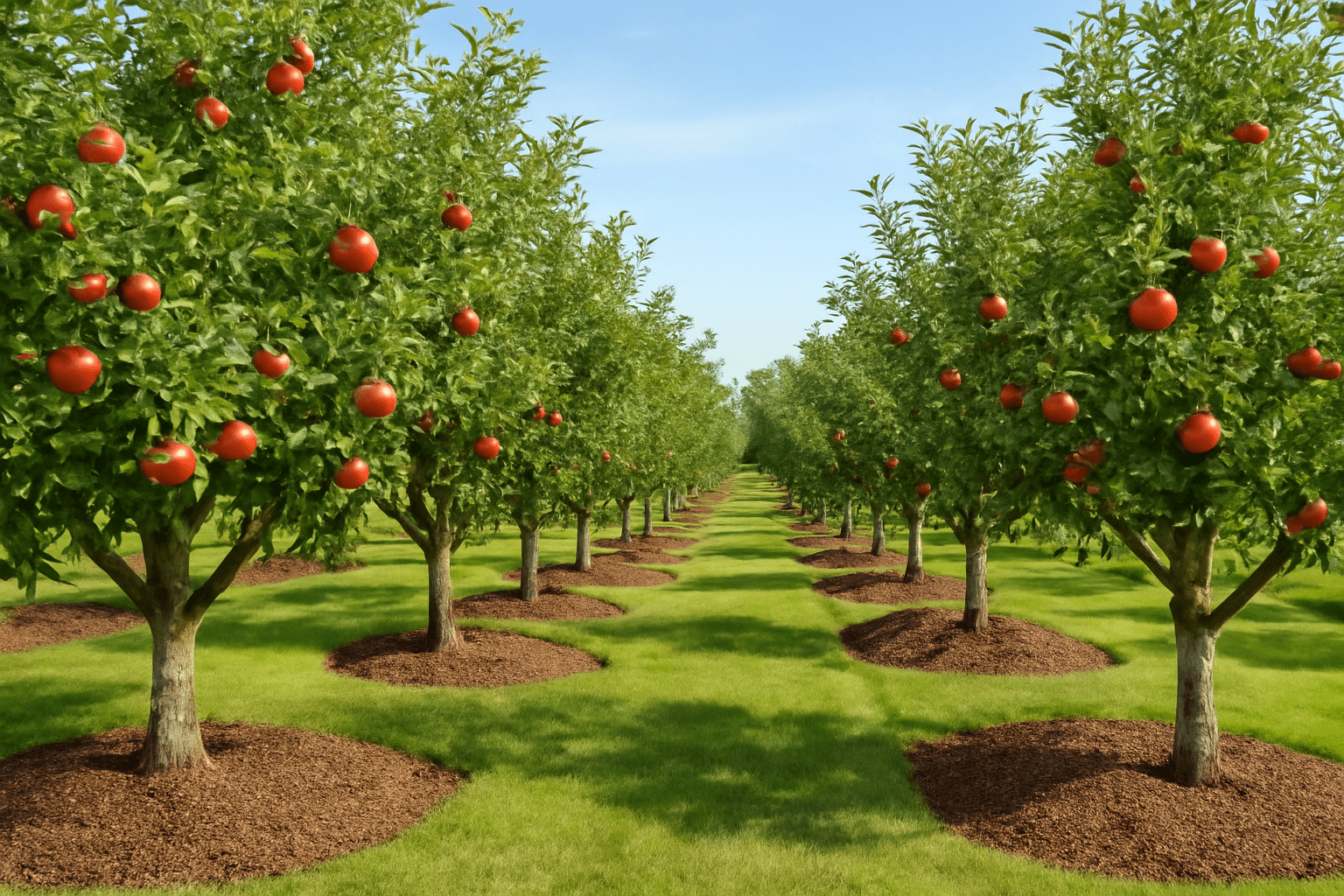
🌱 Maintaining Tree Health 🌱
1. Proper Watering 💧
Consistent watering 💦 is essential for apple tree 🌳 health. Apple trees 🌳 need deep watering 💧, especially during dry spells ☀️, to encourage strong root growth 🌱. However, avoid overwatering 💧, as soggy soil 🌱 can lead to root rot 🦠 and other issues ⚠️. Aim to water 💦 at the base of the tree 🌳, keeping the soil moist 🌿 but not soaked.
Tip: Water 💧 in the early morning 🌅 to prevent fungal growth 🍄 and ensure the water 💦 reaches the roots 🌱 effectively.
2. Fertilization 🌾
Regular fertilization 🌱 helps provide the necessary nutrients 🧪 for healthy tree 🌳 growth and fruit 🍏 production. Apply a balanced fertilizer 🌿 in early spring 🌷 to encourage growth 🌱 and again in late summer 🍂 to support the tree’s energy reserves 🔋 for the winter months ❄️.
Tip: Choose a fertilizer 🧪 designed for fruit trees 🌳, as it will provide the right balance ⚖️ of nitrogen, phosphorus, and potassium.
3. Pruning ✂️
Regular pruning 🌿 removes dead ❌ or diseased branches 🌳, improves air circulation 💨, and allows sunlight ☀️ to reach the tree’s interior 🌳. This reduces the chances of fungal diseases 🍄 and encourages stronger 💪, healthier growth 🌱.
Tip: Prune ✂️ your apple tree 🌳 in late winter ❄️ or early spring 🌸 when it’s dormant 💤 to avoid stressing the tree 🌳.
How a Healthy Tree Naturally Resists Pests and Diseases 🛡️
A healthy tree 🌳 is naturally more resistant 💪 to pests 🐜 and diseases 🦠. By maintaining good care 💚, your apple tree 🌳 will:
- Develop stronger roots 🌱 and branches 🌿: Making it more resilient 💪 to external stressors ⚡.
- Grow dense, healthy foliage 🍃: Which naturally deters pests 🐜 from attacking.
- Produce more fruit 🍏: Which means fewer resources for pests 🐜 to feed on.
🌿 Preventing Future Problems 🌿
1. Mulching to Reduce Weed Growth and Moisture Loss 🌾
Mulch 🍂 is your best friend 🤝 when it comes to maintaining a healthy apple tree 🌳. It helps to:
- Retain Moisture 💦: Keeps the soil around the tree 🌳 consistently moist 🌿, reducing the need for frequent watering 💧.
- Suppress Weeds 🌱: Weeds 🌿 compete with your tree 🌳 for water 💧 and nutrients 🧪, so mulching helps keep them under control ⚖️.
- Insulate the Soil 🌍: Protects the roots 🌱 from extreme temperature fluctuations 🌡️.
Tip: Apply a 3-inch layer 🌿 of organic mulch 🍂 (like wood chips 🪵 or straw 🌾) around the base of the tree 🌳, but avoid piling it up against the trunk 🌳 to prevent rot 🛑.
2. Choosing Pest-Resistant Apple Tree Varieties 🍏
If you’re planting new apple trees 🌳, consider choosing varieties 🍎 that are naturally more resistant 🦠 to pests 🐜 and diseases 🦠. Some varieties have built-in resistance 💪 to common issues like apple scab 🍏, fire blight 🔥, and mildew 🍄, reducing the need for chemical interventions 🧪.
Tip: Research apple tree varieties 🍏 that are suited to your region 🌎 and are known for their pest resistance 🐜. Local gardening experts 👨🌾 or nurseries 🪴 can provide valuable recommendations 🧠.
By focusing on proper watering 💧, fertilization 🌱, pruning ✂️, mulching 🍂, and choosing pest-resistant varieties 🍏, you can set your apple trees 🌳 up for long-term success 🏆. Healthy trees 🌳 are less likely to suffer from pests 🐜 and diseases 🦠, reducing the need for frequent spraying 🧴 and ensuring a bountiful harvest 🍏 year after year. 🌳🍏 In the next section, we’ll wrap up the guide with a quick recap 🔄 and some final tips for maintaining a thriving apple orchard 🍏!
🍏 Final Thoughts 🍏
Protecting your apple trees 🌳 with the right spray 🧴 is an essential part of maintaining a healthy orchard 🍏, but it’s just one piece of the puzzle 🧩. By combining effective apple tree spray 🌿 with long-term care strategies 💪 like proper watering 💧, fertilization 🌱, and pruning ✂️, you’ll set your trees 🌳 up for success 🏆 year after year.
Remember 🧠, whether you choose organic 🌿 or chemical sprays 🧪, timing ⏰ and consistent application 🔄 are key to keeping pests 🐜 and diseases 🦠 at bay. And for those who prefer a more eco-friendly ♻️ approach, natural alternatives 🌱 like neem oil 🌿 and garlic sprays 🧄 offer a safe 🦺, effective 💥 way to protect your trees 🌳 without harming the environment 🌍.

Healthy trees 🌳 don’t just fight off pests 🐜; they thrive 🌱, produce more fruit 🍏, and become more resistant 💪 to future problems 🦠. So, take the time ⏳ to care for your apple trees 🌳 properly, and they’ll reward you with a bountiful harvest 🍏✨.
Feel free to share your experiences 💬 or ask any questions ❓ in the comments below—we’re here to help you grow 🌱 the apple tree 🌳 of your dreams 💭! 🌿
Frequently Asked Questions (FAQ)
When is the best time to spray my apple tree?
The best time to spray apple trees is in early spring before new growth appears, to target pests that overwinter on the tree. Additionally, you should spray during the growing season every 7–14 days, and again in late fall with dormant oil to prepare for winter. Avoid spraying during the hottest part of the day to protect the tree.
Can I use apple tree spray during flowering?
It’s best to avoid spraying during flowering to protect pollinators like bees. Wait until the flowers have faded before applying insecticides or fungicides. If necessary, use organic sprays that are safer for beneficial insects.
What is the difference between organic and chemical apple tree sprays?
Organic sprays, such as neem oil and insecticidal soap, are made from natural ingredients and are less harmful to beneficial insects and the environment. Chemical sprays, on the other hand, are stronger and can be more effective but may harm beneficial insects and the ecosystem if not used properly. Organic options are typically safer for the environment but may need more frequent applications.
How often should I spray my apple tree for pests and diseases?
For most apple tree sprays, you should apply them every 7–14 days during the growing season. If you’re using fungicides or insecticides, follow the instructions on the label to determine the correct interval. Environmental factors like rain and humidity may require more frequent spraying to prevent disease.
Can I make my own apple tree spray at home?
Yes, you can make your own apple tree spray using ingredients like neem oil, garlic, or cayenne pepper. Mix 2 teaspoons of neem oil with 1 quart of water and a few drops of liquid soap for an effective homemade insecticide. Ensure you’re using the right recipe for the pests or diseases you’re targeting.
What should I do if my apple tree shows signs of spray damage?
If your tree shows signs of over-spray or injury, such as browning leaves, prune affected branches and switch to a gentler, organic spray. You can also dilute the solution and reapply to minimize damage. Make sure to follow proper guidelines for future applications to avoid repeating the mistake.
Are there any eco-friendly alternatives to chemical apple tree sprays?
Yes, organic options like neem oil, insecticidal soap, and horticultural oils are great alternatives to chemical sprays. These natural solutions are less toxic to the environment and beneficial insects, making them safer choices for those looking to reduce their impact on nature.
How do I know if apple tree spray is working?
If your apple tree is free from pests, has healthy leaves, and produces good fruit, it’s a sign that the spray is working. If you continue to notice pests or diseases, you may need to reapply the spray, use a different product, or adjust the timing of your applications. Keep an eye on the tree’s health and adjust as necessary.
